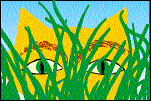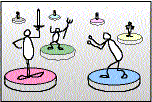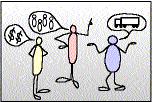|


Why Scan?
Day One of the DesignShop® Process
by Chip Saltsman, Gail Taylor and Matt Taylor
12/18/1997
(edited by James B. Smethurst)
[Editor's note: this article has been compiled from
several e-mail messages exchanged between the authors on November 1-2,
1997.]
"The significant problems we face cannot be solved
at the same level of thinking we were at when we created them." --
Albert Einstein

The Scan Focus Act model is
one of the foundations of the DesignShop process. Scan Focus Act is the
natural way to solve problems, but all too often, groups of people choose
to eliminate one or more pieces of the model, inevitably leading to solutions
that are far less effective. The "Scan" that occurs on Day One
of the DesignShop event allows participants to work well beyond their
usual boundaries, uncovering assumptions and establishing context for
the rest of the event. The "Focus" on Day Two iterates ideas,
begins testing assumptions and strategically positions the organization.
"Act" on Day Three works the strategy developed during Focus
into tactical steps: establishing work processes, projects, time lines
and goals.
In today's corporate environment, we have become very comfortable Focusing
and Acting, but we take little time to Scan. We make assumptions, many
of them unconsciously, and presume that the rest of our colleagues and
the rest of the world share our beliefs. Without a Scan we often find
ourselves well into Act before we discover that we are acting from a very
different vantage point than the people with whom we are working. Day
One of a DesignShop event is often the first time that the participant
group--made up of senior executives and members of all parts of the ValueWeb™
community--have ever worked together. Creating common language, discovering
common and divergent assumptions and forging common understanding is the
critical work of Scan.
Common Language
 Organizations
arrive at a DesignShop event deluded that they are all speaking the same
language, even though they are sometimes aware that they come from different
cultures. Even in a geographically centralized unit, individuals speak
such different languages as accounting or marketing or manufacturing.
These individuals must spend time interacting with each other to define
common terms with which to dialogue about their problem. They need an
opportunity to discover that the people in the back office really do have
the same objectives as the front office folks, but that they are each
coming at the problem from different vantage points. Organizations
arrive at a DesignShop event deluded that they are all speaking the same
language, even though they are sometimes aware that they come from different
cultures. Even in a geographically centralized unit, individuals speak
such different languages as accounting or marketing or manufacturing.
These individuals must spend time interacting with each other to define
common terms with which to dialogue about their problem. They need an
opportunity to discover that the people in the back office really do have
the same objectives as the front office folks, but that they are each
coming at the problem from different vantage points.
Language Specific to the Problem
 Not
only must the group create a common language, but frequently the organization
lacks the tools (and language) to describe or to communicate about their
specific problem or solution. The participants need to discover or to
learn models, ideas and terms with which they can collectively conceptualize
their issues. We frequently see terminology created during the Scan day
resurface later in the DesignShop process as the only way to articulate
a new concept. The "banana model" or the "four knights"
or the "win-win" solution could not gestate, gain acceptance,
and then be wired into the language of the organization without an embryonic
period. Participants are often grappling with new concepts, such as acting
along process lines rather than functional silos, and it takes time to
mentally absorb the new information and patterns. Sponsor team members
have had time to work out possible solutions and internalize them, but
they sometimes forget that they are way ahead of the majority of the participants
who are encountering the information and the problem for the first time.
Most participants need time during the DesignShop process to absorb concepts
new to them. The Scan day gives them time to wrestle with the issues and
make it their own problem, not somebody else's. This is often difficult
to accept for those who think they have the solution, but experience has
shown this to be entirely necessary. Not
only must the group create a common language, but frequently the organization
lacks the tools (and language) to describe or to communicate about their
specific problem or solution. The participants need to discover or to
learn models, ideas and terms with which they can collectively conceptualize
their issues. We frequently see terminology created during the Scan day
resurface later in the DesignShop process as the only way to articulate
a new concept. The "banana model" or the "four knights"
or the "win-win" solution could not gestate, gain acceptance,
and then be wired into the language of the organization without an embryonic
period. Participants are often grappling with new concepts, such as acting
along process lines rather than functional silos, and it takes time to
mentally absorb the new information and patterns. Sponsor team members
have had time to work out possible solutions and internalize them, but
they sometimes forget that they are way ahead of the majority of the participants
who are encountering the information and the problem for the first time.
Most participants need time during the DesignShop process to absorb concepts
new to them. The Scan day gives them time to wrestle with the issues and
make it their own problem, not somebody else's. This is often difficult
to accept for those who think they have the solution, but experience has
shown this to be entirely necessary.
Getting Issues on the Table
 Individuals
frequently come to a session with "their" answer in their hip
pocket. "Their" answer is very likely to be a position-centric
solution limited by their own truncated perspective. They have particular
issues, fears, perceived roadblocks, concerns and hopes that are both
very real and very limiting. "Their" answer is also likely to
hold important components or kernels of ideas that need to be part of
the solution that the entire group finally designs. All of these concerns
and vantage points need to be expressed (one of the reasons the "Take-A-Panel®"
exercise is so valuable). Participants must express their hopes and concerns
and they must listen to others doing the same. Individuals
frequently come to a session with "their" answer in their hip
pocket. "Their" answer is very likely to be a position-centric
solution limited by their own truncated perspective. They have particular
issues, fears, perceived roadblocks, concerns and hopes that are both
very real and very limiting. "Their" answer is also likely to
hold important components or kernels of ideas that need to be part of
the solution that the entire group finally designs. All of these concerns
and vantage points need to be expressed (one of the reasons the "Take-A-Panel®"
exercise is so valuable). Participants must express their hopes and concerns
and they must listen to others doing the same.  By having an opportunity to express and hear
multiple perspectives on the issues, participants will be far more supportive
of a final solution in which they recognize their own contribution. By having an opportunity to express and hear
multiple perspectives on the issues, participants will be far more supportive
of a final solution in which they recognize their own contribution.
Truncated Perspective
Managers of organizations tend to look only at competing organizations
in their own market niche. Pharmaceutical firms are very interested in
the activities of other pharmaceutical firms. Bank managers run around
looking at other banks. This self-referential view is a sure way to remain
with the herd.
There is very little time, opportunity or inclination to look outside
one's own market niche, but that is precisely where the ideas are! That
is where managers will discover ways of doing things that their competitors
have not considered. By looking outside the field of vision that they
have every day, managers can discover innovative ideas that have been
tried and tested, sometimes for years, in other industries. One of the
benefits of holding DesignShop events in our facilities is that participants
are engaged by the new and challenging environment to think in new ways.
New Vantage Points
Our processes and environments encourage participants to look at their
issues from different vantage points than they are used to using. "How
does our organization resemble a rain forest?" "How can we build
a three-dimensional model of a supply chain using a model kit?" Only
be stepping beyond the truncated and self-referential perspective of our
ordinary work life will we find the creative ideas and connections from
which our solution will emerge. If the solution were obvious or easy,
it would have been discovered and implemented long before the DesignShop
event. If a solution has not emerged, it is because either the problem
has not been properly formulated or a collective will has not emerged
to approach the problem in a coordinated way. The DesignShop event is
an opportunity to grapple with tremendously complex problems and to design
appropriate solutions.
Managing Complexity
People are used to putting together linear meetings where they can show
how each piece of the meeting contributes to a bit of the final solution.
Meetings have become so rote that we have difficulty not thinking in linear
ways: make an agenda, push the agenda, manage the discussion. Overwhelming
complexity overwhelms us. People let the traditional linear methods of
meetings and work undermine their own approach to complex problems: "My
problem is so complex that I can only afford to consider one or two options."
By ignoring complexity in order to falsely simplify the issues, we guarantee
that our solutions will address only symptoms of the real problems. By
Scanning the complexity of the issues involved, participants can design
solutions that address the true problem at hand.
Nonlinear Processes
The Scan day is the time in which ideas are floated and explored. It is
a vital day of exploration and communication, but for many participants,
it does not "feel" like the kind of work they are used to. By
the end of the Scan day, we will NOT solve the first third of the problem.
We may be only a ninth of the way through our work. That ninth, however,
is the foundation on which the rest of the work will be constructed. If
the group is introduced to and interacts with the proper mix of ideas,
information and vantage points on Day One, then on Day Three, the group
will complete work that is orders of magnitude more efficient and effective
than they are used to achieving. Act is impossible without Scan. An event
is not a DesignShop without Scan. Scan is not a linear approach to work,
and it makes many participants uncomfortable. It is precisely this non-linearity,
however, that makes the DesignShop process so powerful.
Working Beyond Boundaries
Creativity is usually not engendered by limitless options. More often,
creativity comes from the constraints placed on the organization. NASA
created the Mars Pathfinder precisely because they had a quarter of the
normal budget and a quarter of the time they would normally use. The DesignShop
participant group needs time to explore their boundaries to discover if
they are, indeed, legitimate limits and then to explore creative ways
to escape them. If a group were to move immediately to Focus and Act,
they would neither have understood nor defined their boundaries.
Metaphors
A frequent Scan activity is the Metaphors Exercise, in which participants
are asked to compare their organization to any number of seemingly unrelated
phenomena like an ant colony, a human body, or a rain forest. While this
exercise may seem rather whimsical at first, it forces participants to
step back from their limited perspectives to look at their issues from
the vantage point of another system: teaming and success without centralized
control, in the case of the ant colony. We explicitly identify the issues
underlying an organization's current conditions and design the metaphors
exercise (and the entire DesignShop event) to address those specific issues.
Is the group making assumptions without realizing it? We then design an
assignment around assumptions. Are they grappling with limited resources?
SimCity is all about limited resources. Is leverage a problem? Read up
on Cortes. The topics we select are not supposed to appear relevant at
first. We select them in order to introduce new vantage points, not to
feed the participants terms and metaphors with which they are already
comfortable. The topics we select, however, are chosen very carefully
to pinpoint some of the key issues that the participants are facing.
Discomfort
The challenge that many organizations face is simply that they are too
comfortable. There is no gut-felt reason to change. There is no "burning
platform". Sometimes people understand intellectually that change
in needed, but the pain of the current state is not greater than the anticipated
pain of changing. Making participants uncomfortable is an important way
to induce change. This is the reason for exercises that demonstrate that
participants do not fully understand their problem. This is why a strong
message from the sponsor is so vital. The participants must choose to
change.
The DesignShop process is more interested in generating solutions than
in the minute-to-minute comfort of individual participants. The Scan day
will introduce participants to challenging new vantage points in order
to allow innovative solutions to emerge during Focus and Act. Participants
need to stay uncomfortable long enough to deal with uncertainty, ambiguity
and paradox in order to avoid premature closure. As long as they are comfortable
doing things the way they are used to doing them, they will not change,
and innovation cannot occur.
Very simply, DesignShop processes work. MG Taylor has over 20 years'
experience that documents the power of this process, the key component
of which is the Scan. The Scan allows participants to explore each other
and the vast wealth of knowledge that exists, to play with scenarios and
visions for the future and the past, to generate new understandings of
themselves, their organization and their world, and to build a solid foundation
from which to grow their organization. Without the foundation that Scan
provides, the DesignShop event will produce results that are far less
than optimal. With a proper Scan, the DesignShop process can produce results
unimaginable using traditional ways of work.
  
copyright © 1997, MG Taylor Corporation.
All rights reserved
copyrights,
terms and conditions
19971218164923.web.jbs
|

